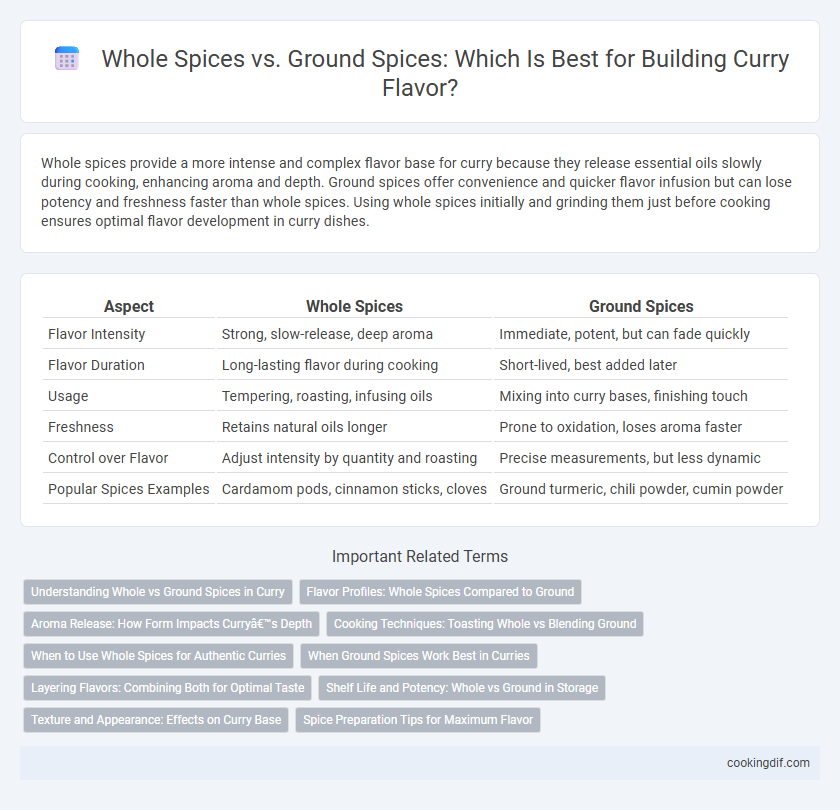Whole spices provide a more intense and complex flavor base for curry because they release essential oils slowly during cooking, enhancing aroma and depth. Ground spices offer convenience and quicker flavor infusion but can lose potency and freshness faster than whole spices. Using whole spices initially and grinding them just before cooking ensures optimal flavor development in curry dishes.
Table of Comparison
| Aspect | Whole Spices | Ground Spices |
|---|---|---|
| Flavor Intensity | Strong, slow-release, deep aroma | Immediate, potent, but can fade quickly |
| Flavor Duration | Long-lasting flavor during cooking | Short-lived, best added later |
| Usage | Tempering, roasting, infusing oils | Mixing into curry bases, finishing touch |
| Freshness | Retains natural oils longer | Prone to oxidation, loses aroma faster |
| Control over Flavor | Adjust intensity by quantity and roasting | Precise measurements, but less dynamic |
| Popular Spices Examples | Cardamom pods, cinnamon sticks, cloves | Ground turmeric, chili powder, cumin powder |
Understanding Whole vs Ground Spices in Curry
Whole spices in curry release essential oils gradually, offering a deeper, more complex flavor base ideal for slow-cooked dishes. Ground spices, being finely powdered, provide immediate and intense heat, enhancing quicker recipes but with a less nuanced profile. Understanding the balance between whole and ground spices enables precise control over aroma, texture, and taste in curry preparation.
Flavor Profiles: Whole Spices Compared to Ground
Whole spices deliver a more complex and intense flavor profile due to the slow release of essential oils during toasting or frying, enhancing the curry's aroma and depth. Ground spices provide convenience with immediate flavor but tend to lose potency faster and can result in a less vibrant taste. Using whole spices like cumin seeds, cardamom pods, or cloves as the flavor base creates a layered, fresher taste compared to the milder, sometimes one-dimensional profile of ground powders.
Aroma Release: How Form Impacts Curry’s Depth
Whole spices retain essential oils longer, releasing aroma slowly during cooking and enhancing the curry's depth with layered fragrance. Ground spices offer immediate aroma release but can lose potency quickly, impacting the overall flavor intensity. Using whole spices as the flavor base creates a richer, more complex curry aroma compared to ground forms.
Cooking Techniques: Toasting Whole vs Blending Ground
Toasting whole spices like cumin, coriander, and cardamom releases essential oils, intensifying their flavor and adding depth to curry dishes. Ground spices provide convenience and quick infusion but can lose potency if not freshly ground or properly stored. Combining toasted whole spices with freshly blended ground spices achieves a robust, layered flavor base for authentic curry preparations.
When to Use Whole Spices for Authentic Curries
Whole spices such as cumin seeds, cardamom pods, and cloves release their essential oils slowly, providing a rich, layered flavor that defines authentic curries. Use whole spices at the beginning of cooking by tempering them in hot oil to unlock their aromatic compounds and build a robust flavor base. Incorporating whole spices enhances texture and depth, making the curry taste more vibrant and traditional compared to ground spices.
When Ground Spices Work Best in Curries
Ground spices work best in curries when a smooth, uniform texture and immediate flavor release are desired, such as in creamy sauces or slow-simmered dishes. They blend seamlessly into the curry base, allowing the spices' essential oils to infuse quickly, enhancing depth and complexity. Using ground spices also helps achieve consistent seasoning throughout the dish without the graininess that whole spices can sometimes create.
Layering Flavors: Combining Both for Optimal Taste
Using whole spices like cumin seeds, cardamom pods, and cinnamon sticks in curries releases essential oils slowly during cooking, creating a deep and complex flavor foundation. Ground spices offer immediate intensity and can be added later to enhance aroma and boost the overall taste profile. Layering both forms strategically ensures a balanced curry with nuanced, vibrant flavors that evolve throughout the cooking process.
Shelf Life and Potency: Whole vs Ground in Storage
Whole spices retain their essential oils and volatile compounds much longer than ground spices, resulting in a shelf life of up to 4 years when stored in airtight containers away from light and heat. Ground spices begin to lose potency within 3 to 6 months due to greater surface area exposure, making them less flavorful over time. Proper storage conditions, such as airtight containers and cool, dark environments, significantly extend the flavor retention of both whole and ground spices used in curry.
Texture and Appearance: Effects on Curry Base
Whole spices in curry bases provide a textured, visually appealing foundation with bursts of flavor as they slowly release essential oils during cooking, enhancing both aroma and complexity. Ground spices blend smoothly into the curry, creating a uniform color and consistent taste but lacking the distinct texture and visual contrast that whole spices offer. Choosing between whole and ground spices influences the curry's mouthfeel and presentation, with whole spices contributing to a layered sensory experience and ground spices ensuring even seasoning distribution.
Spice Preparation Tips for Maximum Flavor
Whole spices, such as cumin seeds, cardamom pods, and cloves, release essential oils gradually when toasted or fried, creating a deeper and more complex flavor base for curries. Grinding spices fresh just before use preserves their potency and aroma, enhancing the dish's overall taste profile. Toasting whole spices before grinding intensifies their flavor, making spice preparation a crucial step for achieving maximum depth and aroma in curry recipes.
Whole spices vs ground spices for flavor base Infographic

 cookingdif.com
cookingdif.com